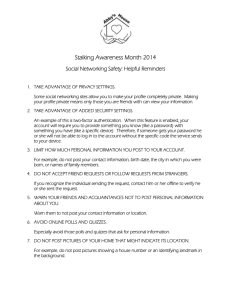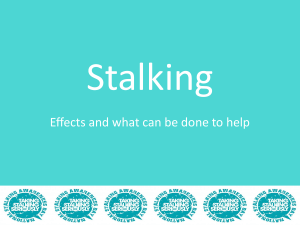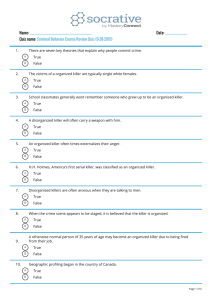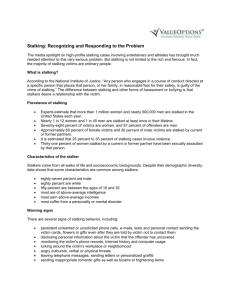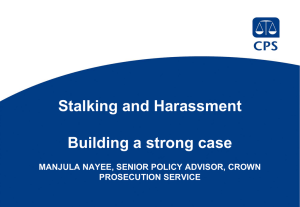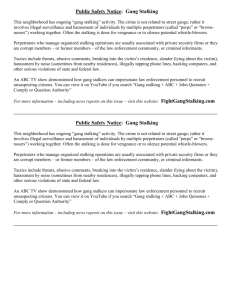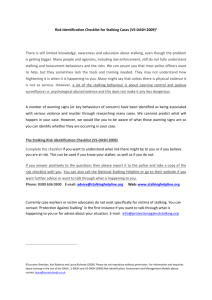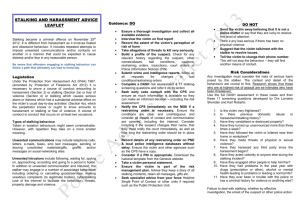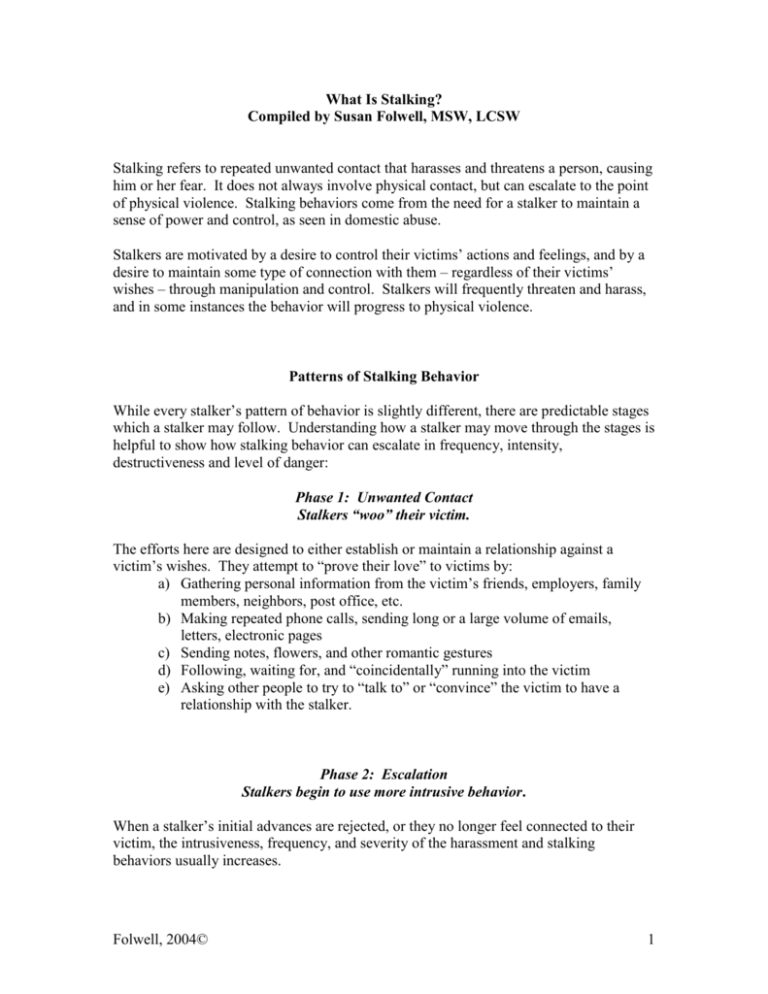
What Is Stalking?
Compiled by Susan Folwell, MSW, LCSW
Stalking refers to repeated unwanted contact that harasses and threatens a person, causing
him or her fear. It does not always involve physical contact, but can escalate to the point
of physical violence. Stalking behaviors come from the need for a stalker to maintain a
sense of power and control, as seen in domestic abuse.
Stalkers are motivated by a desire to control their victims’ actions and feelings, and by a
desire to maintain some type of connection with them – regardless of their victims’
wishes – through manipulation and control. Stalkers will frequently threaten and harass,
and in some instances the behavior will progress to physical violence.
Patterns of Stalking Behavior
While every stalker’s pattern of behavior is slightly different, there are predictable stages
which a stalker may follow. Understanding how a stalker may move through the stages is
helpful to show how stalking behavior can escalate in frequency, intensity,
destructiveness and level of danger:
Phase 1: Unwanted Contact
Stalkers “woo” their victim.
The efforts here are designed to either establish or maintain a relationship against a
victim’s wishes. They attempt to “prove their love” to victims by:
a) Gathering personal information from the victim’s friends, employers, family
members, neighbors, post office, etc.
b) Making repeated phone calls, sending long or a large volume of emails,
letters, electronic pages
c) Sending notes, flowers, and other romantic gestures
d) Following, waiting for, and “coincidentally” running into the victim
e) Asking other people to try to “talk to” or “convince” the victim to have a
relationship with the stalker.
Phase 2: Escalation
Stalkers begin to use more intrusive behavior.
When a stalker’s initial advances are rejected, or they no longer feel connected to their
victim, the intrusiveness, frequency, and severity of the harassment and stalking
behaviors usually increases.
Folwell, 2004©
1
As in domestic violence situations, stalkers may intimidate victims in order to coerce
them into returning to the relationship, or simply to maintain a sense of connection with,
and power over, their victims. Stalkers may now:
a) Spread rumors, negative things, and false information about the victim to
friends, family members, employers, faith organizations, schools (often,
abusers threaten to “expose” their victim, even if the “exposure” is based upon
falsehoods and lies – an effort to control other people’s perceptions of the
situation).
b) Make direct and indirect threats through intimidating phone calls, e-mails,
pages, and sending/leaving notes. (IT IS VERY IMPORTANT FOR A
VICTIM TO KEEP COPIES OF ALL COMMUNICATION FOR
DOCUMENTATION IN THE EVENT THAT THEY NEED TO PROVE
THEY HAVE BEEN STALKED). Threats may be of kidnapping, taking the
children, bitter divorce or custody battle, murder or bodily harm, taking the
victim to court, destruction of property etc.
c) Become more persistent in following the victim
d) Leave evidence to remind a victim of their presence
e) Break into a victim’s home
f) Leave dead animals where a victim will see them
g) Leave weapons or bloody objects where a victim will see or find them
Phase 3: Violence
Stalkers resort to more violence.
As in domestic violence relationships, stalkers may turn to violence when the other
behaviors either do not get them what they want, or have stopped working. When
stalkers/abusers feel they are losing control, they may resort to using violence to assert
their power and dominance over their victims. Stalkers may use:
a)
b)
c)
d)
e)
f)
g)
Severe threats, including blackmail
Vandalism of the victim’s vehicles and property
Physical attacks
Sexual assaults, including rape
Kidnapping
Attempted murder
Murder
Other stalking behaviors may include:
Harassing phone calls –either in frequency, or in the content of the call
Threats – entering, or threatening to enter a victim’s home when no one is
at home; threatening to report the victim to authorities when no crime has occurred; other
threats which cause apprehension or fear
Folwell, 2004©
2
Monitoring the victim’s activities – through GPS devices; by using a victim’s friends,
family, neighbors, or co-workers to monitor and report back on the victim’s whereabouts
and activities; by requiring that a victim “check in” at certain intervals, or answer their
phone at all times
Spying on the victim – a subset of monitoring the victim; may include literally hiding
and spying, overtly showing up at an event or appointment and keeping watch, or
cyberstalking (see below).
Profile of a Stalker
Some stalkers begin the abuse during a relationship with the victim, and use
stalking to maintain and demonstrate continued power and control over their
victims after the relationship has ended. At other times, an abuser may begin to
use stalking behaviors when a victim has asked for changes in the relationship,
has asked for or filed for a divorce, or has initiated a separation. These are
common situations which provoke an escalation in abuse, including either the
onset of or the worsening of, stalking behaviors. In fact, domestic violence
victims are in great danger of being seriously harmed or killed when they are
being stalked by their abusers. Stalkers can become more violent as they feel less
control over their victims.
Common characteristics of stalkers include:
Needing to have (or feel that they have) control over others
Being manipulative
Reacting jealously (sometimes perceiving that a victim is behaving in a
provocative or sexual manner when that is not the case; may falsely accuse
victim of affairs or suspect affairs when there is no reason for the
suspicion)
Being unable to take “no” for an answer (does not have healthy
boundaries)
Being unable to accept and cope with rejection (as in the case of
separation, divorce, “breaking up”. May also perceive rejection when a
victim is simply asking for change)
Lying frequently
Behaving obsessively
Feeling victimized (abusers often say they are the ones being abused
when their victims enforce boundaries and begin to make changes)
Folwell, 2004©
3
Some Facts about Stalking
Stalking is a crime. It can be committed against anyone regardless of
gender, race, sexual orientation, socio-economic status, or geographic
location. The majority of stalkers have been in relationships with their
victims, but a significant percentage either never met their victims, or
were just acquaintances – neighbors, friends, or co-workers.
1.4 million people are stalked annually.
Each year, over one million women and 370,000 men are stalked
in the United States.
Only one half of stalking cases are reported to authorities, and 25%
receive a restraining order.
1 in 20 women will be stalked in their lifetimes.
79% of women know their stalkers; 50% were in an intimate
relationship with their stalker; 80% of these relationships were
abusive.
*Statistics supplied by the National Institute of Justice, the
National Violence Against Women survey conducted by the Center
for Policy Research, and the National Center for Victims of Crime.
What To Do if You Are Being Stalked:
If you become the victim of a stalker, it is important to educate yourself. Stalking
is a crime and there are laws which have been put in place to protect victims of stalkers
and hold the stalker accountable for their crime.
If you are in imminent danger, call 911. Go to a safe place: a police station, the
home of a family member or friend unknown to the stalker, or a public area.
Develop a safety plan. Thinking through what you will need to have in place for
your particular safety, BEFORE an emergency, could mean the difference between
tragedy and safety.
Tell someone. Do not try to deal with this situation alone. Alert friends, family
members, co-workers, law enforcement about the stalker’s behavior, including a
description of your stalker. Ask friends, neighbors, school officials, co-workers to
document anything they see or hear and record the time of the occurrence.
Folwell, 2004©
4
Gather evidence. Physical evidence is a key component to convicting a stalker. If
it can be done safely, photograph the stalker. Also, save and date all written materials
(letters, cards, notes, envelopes, emails), voicemails, and gifts. If the gift is perishable,
take a dated photograph, and save some piece of the evidence if possible (for example,
dry or press flowers, peel the label off food items, etc.). Show the perishable item to
another person to serve as a witness.
Document the stalker’s behavior. List dates, times, places, what happened, and
any witnesses. Record what the stalker was doing, saying, wearing, driving (license
number too), etc. Obtain and keep copies of warrants, protective orders, court orders, etc.
Use an answering machine to screen telephone calls. Have a friend (preferably of
the opposite sex) record your answering machine message.
Never underestimate the stalker’s potential for violence. Even though it may be
difficult to believe that this person is capable of violent acts, take every threat seriously.
File charges when appropriate or necessary. Call police or go to the magistrate
immediately and request a warrant each time the stalker breaks the law. The stalker may
be arrested. If arrested, there is a possibility that the stalker will be bonded, and released.
Ask that a condition of the bond be that there will be no contact with you. Obtain copies
of all documents and the name of the magistrate.
Obtain a protective order when appropriate. If a stalking warrant is issued, you
may file for a protective order at the General District Court clerk’s office. If the stalker is
a family/household member, or you have children in common, contact the Court Services
Unit at the Juvenile and Domestic Relations District Court.
NOTE: many victims are urged to get restraining or protective orders.
Remember that this is just a piece of paper. It is only as good as the moral makeup of the
stalker, who may or may not choose to follow the restrictions. If a stalker feels thwarted,
a protective order may provoke rage, and the stalker may feel humiliated and further
rejected. Many times, when a victim obtains a protective order, the threat of bodily harm
actually increases.
Arrange for a neutral place for your stalker. If you have children with your
stalker, arrange for a neutral and safe place to drop them off and pick them up for
visitation, preferably a public place.
Consider moving. If you feel you or any of your family members or friends are in
immediate danger, consider moving to a safe place, such as a domestic violence shelter or
friends’ or families’ residences that are unknown to the stalker.
The following web sites have more information on stalking and what to do if you
are being stalked: www.antistalking.com and www.stalkingassistance.com
Folwell, 2004©
5
What is Cyber Stalking?
As more and more people are gaining access to the Internet there is an increasing
awareness of a new form of stalking called cyber stalking. Cyberstalking is the use
of the Internet, and other forms of electronic communications to harass or
threaten someone repeatedly. This can involve e-mail, harassment in live chat
situations, and using the victims’ code name or e-mail address after leaving
inappropriate messages on message boards or guest books, sending viruses, or
electronic theft identity.
By using e-mail the stalker can send spam (large volumes of unsolicited junk
mail) and send pornographic materials to work or family accounts. They may
also send critical, accusatory, abusive emails as in the case of domestic violence
especially after relationships have ended. In live chat situations the harassment
may involve "flaming", or on-line verbal abuse, sexual harassment, and repeated
attempts at "private chats". Electronic identity theft is use of the Internet to gain
personal information. There are on-line services that will give your social security
number, financial history, personal information, and a detailed map to your
house.
Cyber stalking can be as terrifying as IRL (in real life) stalking, but often harder to prove
and more difficult to control. The anonymity of the Internet works for the stalker, but
there are safety procedures to help anyone on-line and those being cyber stalked. Do not
give out personal information on-line, do not use your real name or nickname on-line,
and be very careful about meeting on-line acquaintances in person. If you are being cyber
stalked change e-mail accounts, and again as with IRL if possible keep old account open
to document on-going abuse and only give new information those who really need it. If
you cannot change accounts look in to filter programs. Within a chat room use genderneutral nicknames, do not use real e-mail addresses, be careful with profiles, use ignore
options, and do not answer individual chat requests. Notify the chat administrator or
room moderators of abuse. If you are being harassed through e-mail or through a chat
room you can notify the Internet provider; most Internet providers have either a
complaints account at postmaster@domainnam or abuse@domainname.
Can Cyber Stalking be Dangerous?
YES! If a stalker takes it offline and you start receiving snail mail or harassing
phone calls from the stalker, then they know where you live. Stalking is about the need
for a stalker to maintain a sense of control over their victim’s actions and feelings, and
the desire to maintain some kind of a connection. If a person is stalking you online, they
may well be capable of doing the same offline, with the progressive escalation discussed
earlier.
Folwell, 2004©
6
For more help on-line and more safety measures there are several web sites
devoted to cyber stalking; www.haltabuse.org and www.cyberangels.org offer
suggestions and support to those being cyber stalked.
References: “Stalking: A Guide for Victims,” Virginia Department of Criminal Justice
Services, June 2000, http://www.dcjs.virginia.gov/victims/documents/stalking.pdf
The National Center for Victims of Crime, www.ncvc.org, “10 Things You Need to
Know About Stalking”
Antistalking.com
CyberAngels.org
Folwell, 2004©
7


